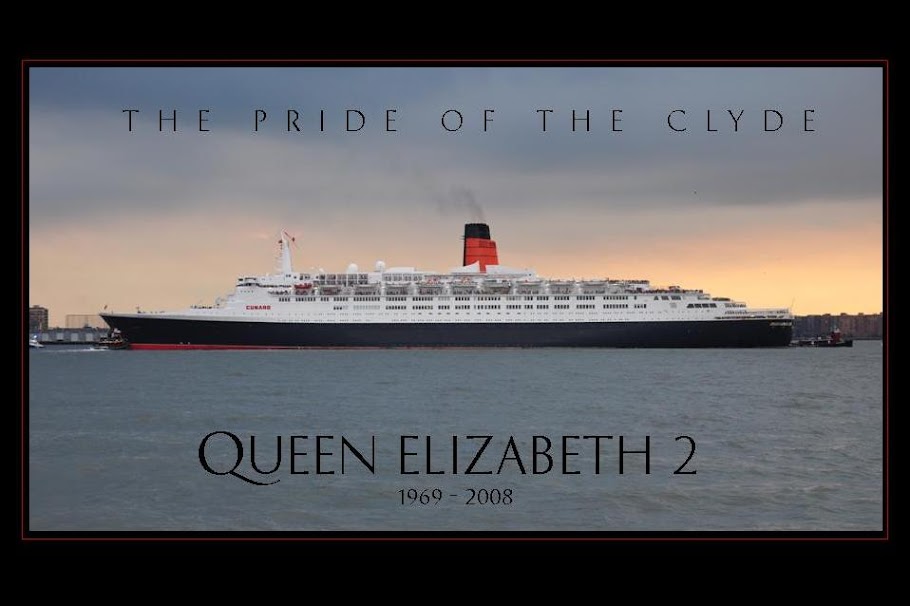View from the Titan Crane of the location of the slipway of the former John Brown Shipyard.
Forty-five years ago, QE2 was launched into the River Clyde on the very slipway used to construct and
launch the previous Cunard Queens. It is also about four years ago, when I embarked on a trip of a lifetime, made possible by my employer, Centerbrook Architects, who awarded me a travel grant with the stipulation that I take the trip and report back on a piece of architecture that peaked my interest. As I am preparing to make my presentation (finally) to the office, I am reminded of my trip to Clydebank, the birthplace of QE2, on this very trip. So what is the real connection here between QE2 and the subject of my travel grant? It wasn't until afterwards that I actually discovered several apparent links between the new Parliament Building that I selected as the subject of my travel grant and my favorite ship, QE2.
Then there were the cost overuns, a sore subject to many a thrifty Scot, many whom could not justify the 430 million pound cost, of which my tour guide was quick to put into perspective. More money was spent on a certain soccer, er football stadium in England, the new Wembly Stadium. That structure was only to play sports and have concerts in and not to symbolize the spirit of an entire liberated Scotland.
I would end up visiting the building on a sunny afternoon, and then the following morning, when the building was open for guided tours. Without tipping off anyone in my tour group, nor the tour guide, of my profession, we made our way through the building and I listened to all the comments. People were initially skeptical and unaware of all of the subtle references and tie-ins to the history of Scotland and it's people. I walked away with a much deeper understanding of the building, with my preconceived notions of what the building should be completely shattered. Months later, after staring at the above image of the entrance, it dawned on me that the entry structure was in fact, stylized representations of the various cranes I saw at every port and along the Clyde. Shipbuilding on the Clyde is an essential chapter in the history of Scotland and here was a subtle nod to it right at the entrance. The tour guide did not mention this. Clearly RMJM and Miralles detailing here was an intentional, but there is an even more blatant Clydebank connection that is tied into another controversial feature of the building, the window "curtains."
Staring at you at the foot of Cannongate and the intersection of Horse Wynd and Abbeyhill, the new Parliament is constructed of various smaller scaled structural masses, designed to fit into the the site and not overpower it. Miralles envisioned the Parliament as growing out of the site and connected to the land as Scotland is a land and not just part of the UK. Here we see a ship on the slipway, sculpted in concrete, with larger building volumes looming above. Here we also see one of the buildings most talked about features, the window screens, rendered in thin granite.
Miralles trajecally died before he could see his vision completed. His wife and partner in his architectural practice, Benedetta Tagliabue, completed his vision. When pressed for an explanation for the curtains, often referred to derogatorily as "anvils" and literal window dressing, she offered little explanation, revealing that the design is simply that of a window curtain pulled back. Her late husband however, enjoying the use of ambiguous forms with multiple meanings, had previously said he would love the profile to evoke an icon of Scottish culture, the painting of Reverend Walker skating on ice, of which he purportedly had a copy of the Henry Raeburn painting on his desk. I'm not buying that for a minute.
The curtains are cranes! They represent the cranes as depicted in these near identical photos of Queen Mary and Queen Elizabeth 2 on the slipway, under construction at the John Brown shipyard. Mystery solved and a clever reference to shipbuilding on the Clyde. In fact, the profile does remind me of the Titan Crane, which we visited during our QE2 port call of Greenock, Scotland. With another picture perfect day, we visited the site of the former John Brown Shipyard and witnessed all that remains of this once great yard and birthplace of the original Cunard Queens.
Here below is the direct comparison of the Queens and the Parliament Building, which was NOT mentioned by the tour guide, but from my own ship based imagination. I think I am on to something.
Moving on to the interiors, there are interesting column detailing throughout that bears a striking resemblance to the iconic QE2 funnel. I realize this is a stretch, but is it really?
RMJM clearly has a fondness for QE2 since they recently completed an apartment project in Glasgow, on the River Clyde, with massing strikingly similar to QE2's original funnel design. In fact, the building has been dubbed the 'QE3' building. Food for thought.
Hopefully over time, others might see these references and tour guides will tie in QE2, Scotland's finest example of shipbuilding to the new Parliament Building.












